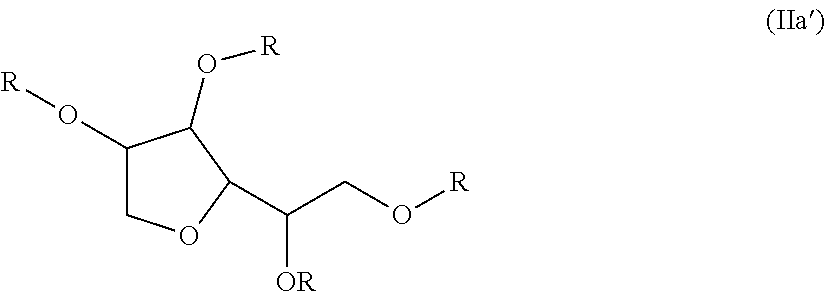Non-fluorinated urethane based coatings
a technology of urethane and coating, which is applied in the field of water-soluble compositions, can solve the problems of less effective than fluorinated counterparts, and achieve the effect of increasing durable water repellency and imparting durable water repellency
- Summary
- Abstract
- Description
- Claims
- Application Information
AI Technical Summary
Benefits of technology
Problems solved by technology
Method used
Image
Examples
example 1
[0104]In a 4-neck round bottom flask equipped with an overhead stirrer, thermocouple, dean-stark / condenser was added sorbitan tristearate (116.0 g; Hydroxy Number=77.2 mgKOH / g) and 4-methyl-2-pentanone (MIBK, 150 g). The solution was refluxed for 1 hour to remove any residual moisture. After the hour, the solution was cooled to 50° C. and DESMODUR N-100 (30 g) was added followed by a catalyst and the solution was heated to 80° C. over one hour.
example 2
[0105]An aqueous dispersion of the compound as described in Example 1 was prepared. Water (300 g), ARMEEN DM-18D (5.6 g), TERGITOL TMN-10 (2.8 g), and acetic acid (3.4 g) was added to a beaker and stirred to from a surfactant solution. The solution was heated to 60° C. The sorbitan urethane / MIBK solution, as prepared in Example 1, was cooled to 60° C. and the surfactant solution was added slowly to produce a milky emulsion. The mixture was homogenized at 6000 psi, and the resulting emulsion was distilled under reduced pressure to remove the solvent, yielding a non-flammable urethane dispersion at 25% solids. This urethane dispersion was applied to textiles and tested according to the test methods above.
examples 3 to 23
[0106]Examples 3 to 23 demonstrate various compounds of the present invention prepared as described in Examples 1 (compounds) and Example 2 (dispersions) with an isocyanate (DESMODUR N100) and one or more different compounds of Formula (Ia) such as sorbitan tristearate, sorbitan trioleate, sorbitain monostearate, and mixtures thereof. When more than one sorbitan ester reagent was used, the second sorbitan reagent was added, and the reaction mixture was heated at 80° C. for an additional four hours. Examples 3 to 23 were applied as dispersions to textiles at 60 g / L, and tested according to the test methods above.
PUM
| Property | Measurement | Unit |
|---|---|---|
| melting point | aaaaa | aaaaa |
| melting point | aaaaa | aaaaa |
| melting point | aaaaa | aaaaa |
Abstract
Description
Claims
Application Information
 Login to View More
Login to View More - R&D
- Intellectual Property
- Life Sciences
- Materials
- Tech Scout
- Unparalleled Data Quality
- Higher Quality Content
- 60% Fewer Hallucinations
Browse by: Latest US Patents, China's latest patents, Technical Efficacy Thesaurus, Application Domain, Technology Topic, Popular Technical Reports.
© 2025 PatSnap. All rights reserved.Legal|Privacy policy|Modern Slavery Act Transparency Statement|Sitemap|About US| Contact US: help@patsnap.com



